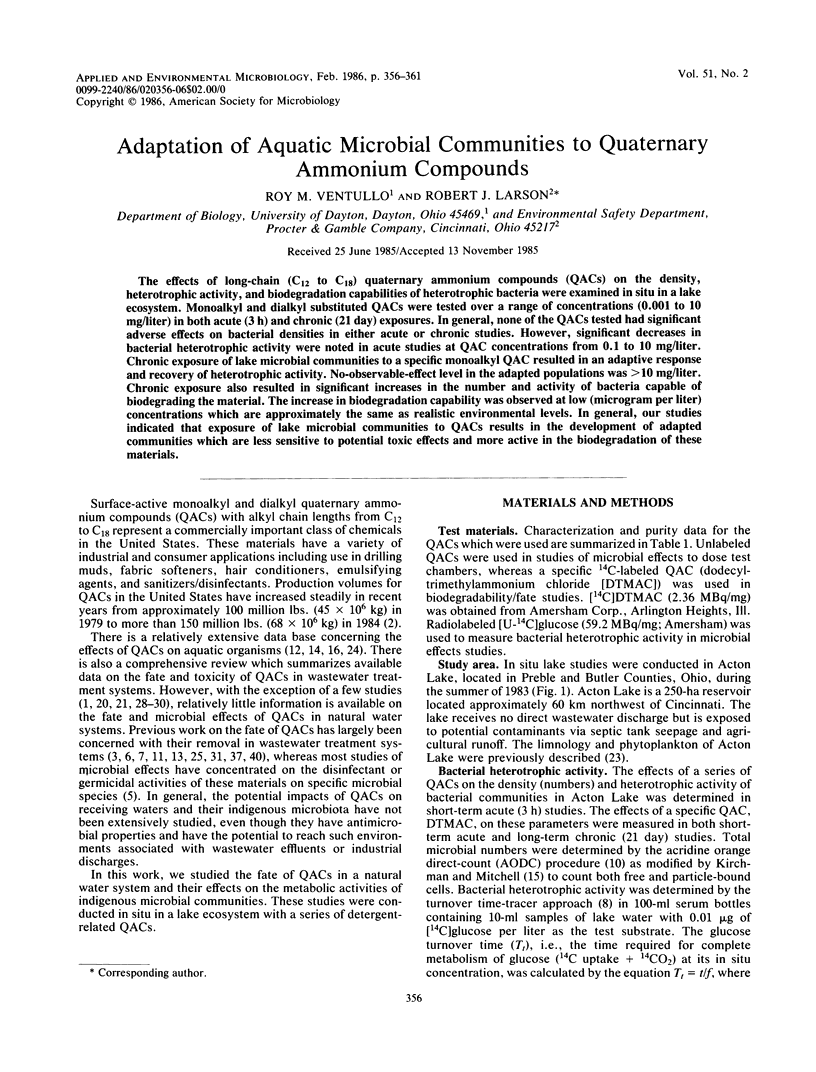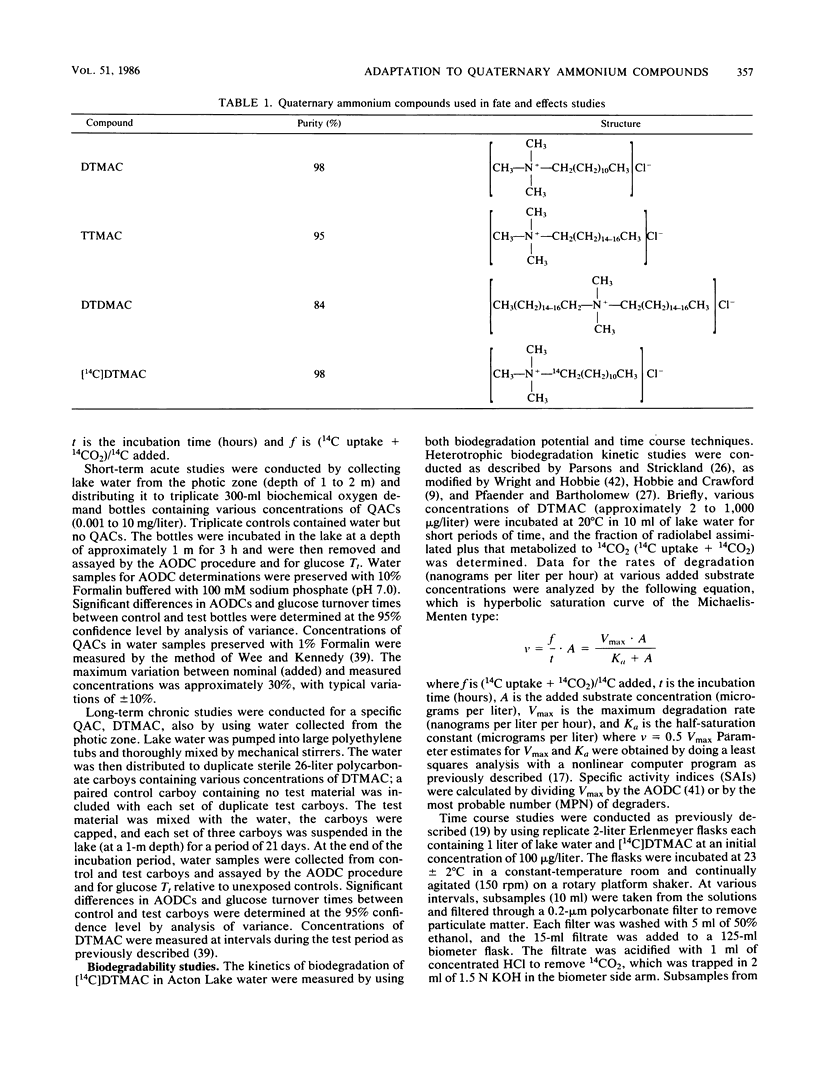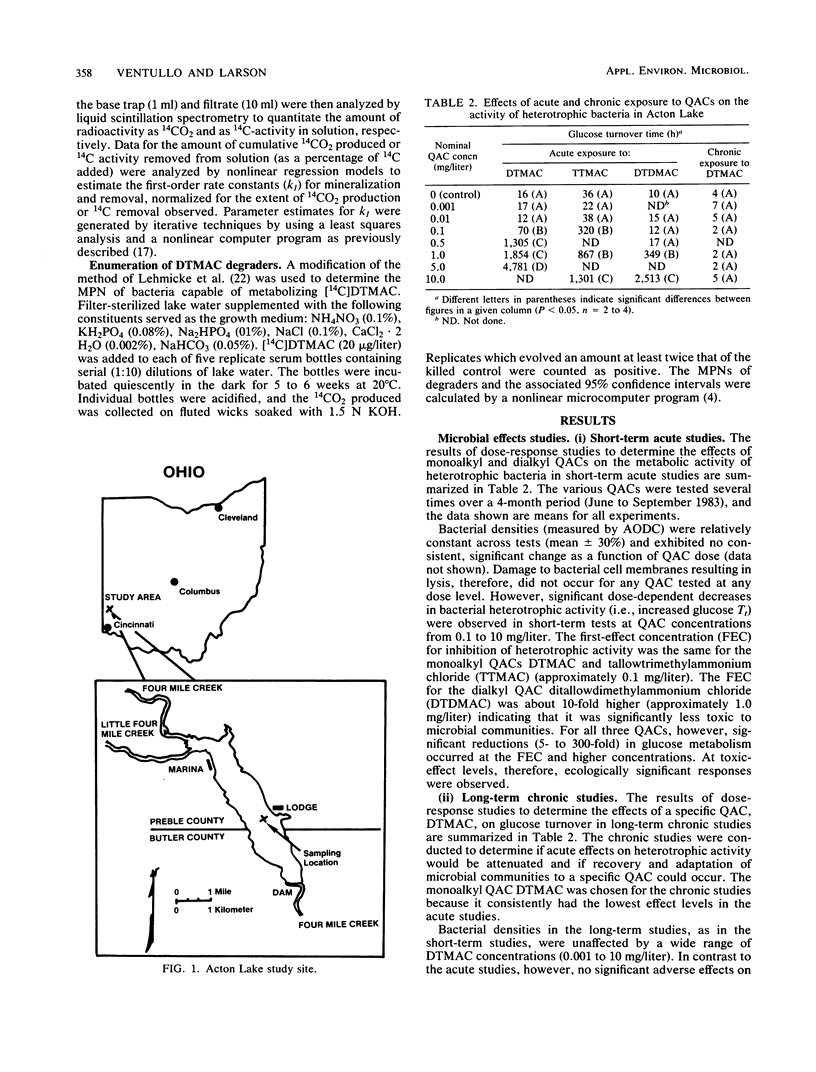Abstract
The effects of long-chain (C12 to C18) quaternary ammonium compounds (QACs) on the density, heterotrophic activity, and biodegradation capabilities of heterotrophic bacteria were examined in situ in a lake ecosystem. Monoalkyl and dialkyl substituted QACs were tested over a range of concentrations (0.001 to 10 mg/liter) in both acute (3 h) and chronic (21 day) exposures. In general, none of the QACs tested had significant adverse effects on bacterial densities in either acute or chronic studies. However, significant decreases in bacterial heterotrophic activity were noted in acute studies at QAC concentrations from 0.1 to 10 mg/liter. Chronic exposure of lake microbial communities to a specific monoalkyl QAC resulted in an adaptive response and recovery of heterotrophic activity. No-observable-effect level in the adapted populations was >10 mg/liter. Chronic exposure also resulted in significant increases in the number and activity of bacteria capable of biodegrading the material. The increase in biodegradation capability was observed at low (microgram per liter) concentrations which are approximately the same as realistic environmental levels. In general, our studies indicated that exposure of lake microbial communities to QACs results in the development of adapted communities which are less sensitive to potential toxic effects and more active in the biodegradation of these materials.
Full text
PDF





Selected References
These references are in PubMed. This may not be the complete list of references from this article.
- Hobbie J. E., Daley R. J., Jasper S. Use of nuclepore filters for counting bacteria by fluorescence microscopy. Appl Environ Microbiol. 1977 May;33(5):1225–1228. doi: 10.1128/aem.33.5.1225-1228.1977. [DOI] [PMC free article] [PubMed] [Google Scholar]
- Kirchman D., Mitchell R. Contribution of particle-bound bacteria to total microheterotrophic activity in five ponds and two marshes. Appl Environ Microbiol. 1982 Jan;43(1):200–209. doi: 10.1128/aem.43.1.200-209.1982. [DOI] [PMC free article] [PubMed] [Google Scholar]
- Larson R. J., Payne A. G. Fate of the benzene ring of linear alkylbenzene sulfonate in natural waters. Appl Environ Microbiol. 1981 Mar;41(3):621–627. doi: 10.1128/aem.41.3.621-627.1981. [DOI] [PMC free article] [PubMed] [Google Scholar]
- Lehmicke L. G., Williams R. T., Crawford R. L. 14C-most-probable-number method for enumeration of active heterotrophic microorganisms in natural waters. Appl Environ Microbiol. 1979 Oct;38(4):644–649. doi: 10.1128/aem.38.4.644-649.1979. [DOI] [PMC free article] [PubMed] [Google Scholar]
- Pfaender F. K., Bartholomew G. W. Measurement of aquatic biodegradation rates by determining heterotrophic uptake of radiolabeled pollutants. Appl Environ Microbiol. 1982 Jul;44(1):159–164. doi: 10.1128/aem.44.1.159-164.1982. [DOI] [PMC free article] [PubMed] [Google Scholar]
- Sayama N. [Microbiological studies on waste water treatment by medical schools and hospitals. (III). Treatment of benzalkonium chloride and chlorhexidine (author's transl)]. Nihon Eiseigaku Zasshi. 1981 Feb;35(6):869–873. [PubMed] [Google Scholar]
- Schmidt S. K., Alexander M. Effects of dissolved organic carbon and second substrates on the biodegradation of organic compounds at low concentrations. Appl Environ Microbiol. 1985 Apr;49(4):822–827. doi: 10.1128/aem.49.4.822-827.1985. [DOI] [PMC free article] [PubMed] [Google Scholar]
- Shehata T. E., Marr A. G. Effect of nutrient concentration on the growth of Escherichia coli. J Bacteriol. 1971 Jul;107(1):210–216. doi: 10.1128/jb.107.1.210-216.1971. [DOI] [PMC free article] [PubMed] [Google Scholar]
- Shimp R. J., Pfaender F. K. Influence of easily degradable naturally occurring carbon substrates on biodegradation of monosubstituted phenols by aquatic bacteria. Appl Environ Microbiol. 1985 Feb;49(2):394–401. doi: 10.1128/aem.49.2.394-401.1985. [DOI] [PMC free article] [PubMed] [Google Scholar]
- Spain J. C., Pritchard P. H., Bourquin A. W. Effects of adaptation on biodegradation rates in sediment/water cores from estuarine and freshwater environments. Appl Environ Microbiol. 1980 Oct;40(4):726–734. doi: 10.1128/aem.40.4.726-734.1980. [DOI] [PMC free article] [PubMed] [Google Scholar]
- Spain J. C., Van Veld P. A. Adaptation of natural microbial communities to degradation of xenobiotic compounds: effects of concentration, exposure time, inoculum, and chemical structure. Appl Environ Microbiol. 1983 Feb;45(2):428–435. doi: 10.1128/aem.45.2.428-435.1983. [DOI] [PMC free article] [PubMed] [Google Scholar]
- Wierich P., Gerike P. The fate of soluble, recalcitrant, and adsorbing compounds in activated sludge plants. Ecotoxicol Environ Saf. 1981 Jun;5(2):161–170. doi: 10.1016/0147-6513(81)90031-2. [DOI] [PubMed] [Google Scholar]
- Wright R. T. Measurement and significance of specific activity in the heterotrophic bacteria of natural waters. Appl Environ Microbiol. 1978 Aug;36(2):297–305. doi: 10.1128/aem.36.2.297-305.1978. [DOI] [PMC free article] [PubMed] [Google Scholar]
- van der Kooij D., Visser A., Hijnen W. A. Growth of Aeromonas hydrophila at Low Concentrations of Substrates Added to Tap Water. Appl Environ Microbiol. 1980 Jun;39(6):1198–1204. doi: 10.1128/aem.39.6.1198-1204.1980. [DOI] [PMC free article] [PubMed] [Google Scholar]


